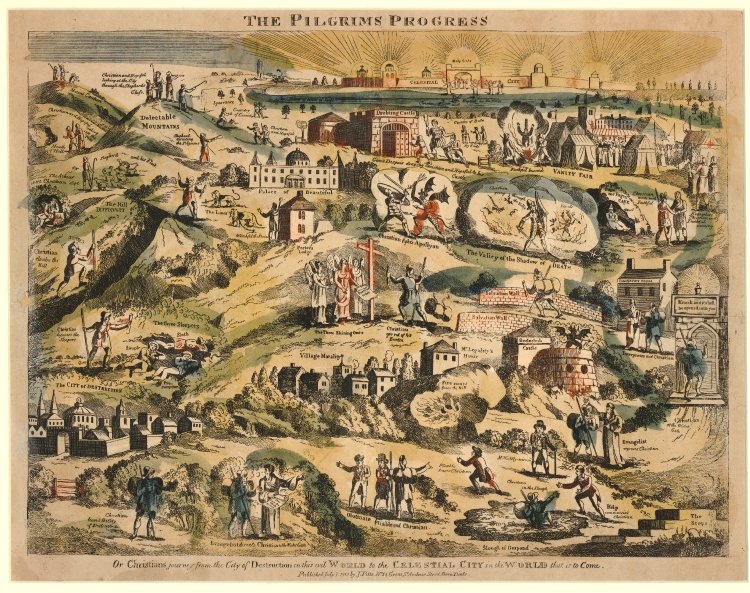Have you seen the newest movie version of The Pilgrim’s Progress? Did you know there are other movie versions? Have you read the original book? What about one of the {many} retellings?
Odds are good that, even if you have never seen a movie version, or read a literary version, you are familiar with the idea of The Pilgrim’s Progress. Why?
Simply put, The Pilgrim’s Progress is one of the most recognizable, most translated, most sold works in the English language. And that’s significant given that Shakespeare also wrote in the English language. In fact, The Pilgrim’s Progress has never been out of print since it was first published in 1678.
John Bunyan was a bold Baptist preacher in a time when the state-approved church was not Baptist (it was what, today, we call Anglican). When he didn’t stop preaching the Word of God, Bunyan landed in prison. Did he stop preaching in prison? If you’ve read The Pilgrim’s Progress, you will know that he did not stop preaching in prison; he merely continued via the written word!

The Pilgrim’s Progress is an allegory, a story in which nearly every fictional character, scene, and situation is a stand-in for real truth, real people and places. Animal Farm is another well-known allegory, but while Animal Farm is about an earthly/material reality (Lenin, Stalin, and the rise of Communism), ThePilgrim’s Progress is ultimately about our spiritual journey as Christians though this life until the next. As Christian travels on his journey to the Celestial City through, by, or around such areas as the Slough of Despond, Doubting Castle, or Vanity Fair, he meets many characters with names that clearly indicate their helpfulness or harmfulness to his quest: Faithful, Hopeful, Timorous, Pliable, Obstinate, or the dreaded Apollyon.
Leland Ryken reminds us:
There is a right way and wrong way to deal with the allegorical aspect of The Pilgrim’s Progress. The wrong way is to slight the literal, physical level of action on the premise that the religious meaning is what really matters. The right way is to abandon ourselves to the story qualities of the work and let the second level of understanding grow out of that narrative experience. Giant Despair first of all needs to be a terrifying giant in our imagination, and then he becomes a picture of psychological and theological realities.
~From the foreword to The Pilgrim’s Progress, Desiring God version
First published as The Pilgrim’s Progress from This World, to That Which Is To Come, it was followed a few years later by the story of Christian’s wife, Christiana, and their children. Both are worth reading, but the first story is the most famous and beloved.
If we’ve whetted your appetite, you can find out more about John Bunyan, access a free pdf version from Desiring God with helpful commentary, or find the work on Project Gutenburg. There are many simplified versions for children and those for whom the original is a difficult read. We’ll be looking at a few of those in the coming weeks. Stay tuned as we unpack more about The Pilgrim’s Progress this month!
Support our writers and help keep Redeemed Reader ad-free by joining the Redeemed Reader Fellowship.
Stay Up to Date!
Get the information you need to make wise choices about books for your children and teens.
Our weekly newsletter includes our latest reviews, related links from around the web, a featured book list, book trivia, and more. We never sell your information. You may unsubscribe at any time.
We'd love to hear from you!
Our comments are now limited to our members (both Silver and Golden Key). Members, you just need to log in with your normal log-in credentials!
Not a member yet? You can join the Silver Key ($2.99/month) for a free 2-week trial. Cancel at any time. Find out more about membership here.
1 Comments
Leave a Comment
You must be logged in to post a comment.



HI there,
I came across your site by searching for Pilgrim’s Progress images. I love the image (map image from British Museum) and wondered how you get permission to use this image? Thanks for your help and for promoting good books !!
God bless Dennis